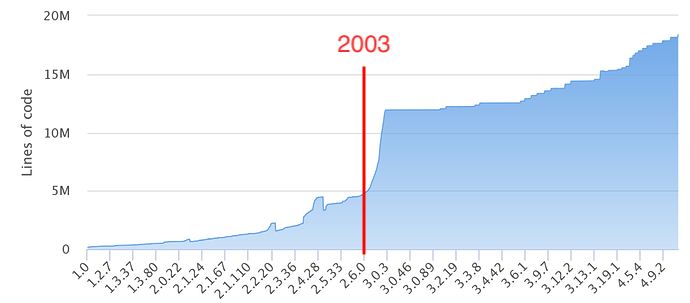Linux 操作系统
从 CPU Reset 后的 “硬件初始状态” 到操作系统加载完 init 进程后的 “软件初始状态”,从此以后,计算机系统中的一切都是由应用程序主导的,操作系统只是提供系统调用这一服务接口。
本讲内容:完整的应用世界到底是如何构建的?在这节课中,我们用一个 “最小” 的 Linux 系统解答这个问题:
- Linux 操作系统
- Linux 系统启动和 initramfs
- Linux 应用世界的构建
Linux 历史
25 Aug 1991, The Birthday of Linux
Hello, everybody out there using minix – I’m doing a (free) operating system (just a hobby, won’t be big and professional like gnu) for 386(486) AT clones. This has been brewing since April, and is starting to get ready.
—— Linus Torvalds (时年 21 岁)
Linux 是基于宏内核,而 Minix 是基于微内核。
Minix
Minix: 完全用于教学的真实操作系统 by Andrew S. Tanenbaum
年轻人的第一个 “全功能” 操作系统
- Minix1(1987): UNIXv7 兼容
- Linus 实现 Linux 的起点
- Minix2(1997): POSIX 兼容
-
更加完备的系统,书后附全部内核代码
-
Minix3(2006): POSIX/NetBSD 兼容
- 一度是世界上应用最广的操作系统:Intel ME 人手一个
Linux 代码行数

- Linux 2.0 引入多处理器 (Big Kernel Lock, 内核不能并行)
- Linux 2.4 内核并行
- 2002 年才引入 Read-Copy-Update (RCU) 无锁同步
- 2003 年 Linux 2.6 发布,随云计算开始起飞
构建最小 Linux 系统
启动 Linux
控制 Linux Kernel 加载的 “第一个状态机”?—— rdinit
挑战 ChatGPT:
- 我希望用 QEMU 在给定的 Linux 内核完成初始化后,直接执行我自己编写的、静态链接的 init 二进制文件。我应该怎么做?
熟悉的 QEMU,稍稍有些不熟悉的命令行选项
- 再次挑战 ChatGPT:如果我希望用 QEMU 启动我给定的 Linux 内核二进制文件 vmlinuz 和初始内存文件系统 initramfs,应该使用怎样的 QEMU 参数使得 initramfs 中的 /bin/hello 作为第一个执行的程序?
initramfs:
# Copy kernel and busybox from the host system
@mkdir -p build/initramfs/bin
sudo bash -c "cp /boot/vmlinuz build/ && chmod 666 build/vmlinuz"
cp $(INIT) build/initramfs/
cp $(shell which busybox) build/initramfs/bin/
run:
# Run QEMU with the installed kernel and generated initramfs
qemu-system-x86_64 \
-serial mon:stdio \
-kernel build/vmlinuz \
-initrd build/initramfs.cpio.gz \
-machine accel=kvm:tcg \
-append "console=ttyS0 quiet rdinit=$(INIT)"
initrd
initrd(boot loader initialized RAM disk)只是一个内存里的小文件系统
内核启动被分成了两个阶段:
- 第一阶段先执行 initrd 文件系统中的"某个文件"(init 程序),完成加载驱动模块等任务
- 第二阶段才会执行真正的文件系统中的任务 /sbin/init 进程(实际是
systemmd,软链接)。 - 包括加载剩余必要的驱动程序,例如网卡/显卡驱动;
pivot_root
pivot_root()changes the root mount in the mount namespace of the calling process. More precisely, it moves the root mount to the directoryput_oldand makesnew_rootthe new root mount. The calling process must have theCAP_SYS_ADMINcapability in the user namespace that owns the caller's mount namespace.
在 init 时多做一些事
export PATH=/bin
busybox mknod /dev/sda b 8 0
busybox mkdir -p /newroot
busybox mount -t ext2 /dev/sda /newroot
exec busybox switch_root /newroot/ /etc/init
- pivot_root 之后才加载网卡驱动、配置 IP
- 这些都是 systemd 的工作 (你会留意到 tty 字体变了)
- 之后 initramfs 就功成身退,资源释放